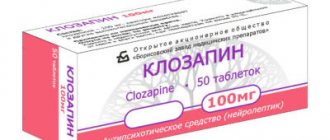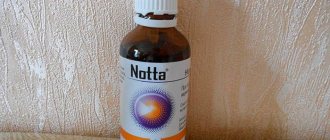Prohibited during pregnancy
Prohibited during breastfeeding
Prohibited for children
Has restrictions for older people
Has limitations for liver problems
Has limitations for kidney problems
Ketilept is an effective antipsychotic drug that is infrequently prescribed by domestic psychiatrists due to its high price. The drug is produced at the Eric pharmaceutical plant in Budapest, Hungary. According to the instructions for use, Ketilept is effective for psychosis, depressive conditions and schizophrenia in adult patients.
Pharmacological properties of the drug Ketilept
Pharmacodynamics. Quetiapine is an atypical antipsychotic drug that has an antagonistic effect on brain neurotransmitter receptors. Quetiapine has an affinity for serotonin (5HT1A and 5HT2), dopamine (D1 and D2), histamine (H1) and adrenergic (α1 and α2) receptors; higher affinity for 5HT2 receptors than for D1 and D2 receptors. Quetiapine also has a high affinity for histaminergic (H1) and α1-adrenergic receptors and a lower affinity for α2 receptors, while having no noticeable affinity for muscarinic cholinergic or benzodiazepine receptors. The mechanism of action of quetiapine, like other antipsychotic drugs, is unknown. Drowsiness during the action of quetiapine can be explained by its high affinity for histamine (H1) receptors. Similarly, orthostatic hypotension during quetiapine administration may be explained by its high affinity for α1-adrenergic receptors. Pharmacokinetics . After oral administration, quetiapine is rapidly absorbed into the gastrointestinal tract. The maximum concentration in blood plasma is observed after 1.5 hours. Food intake affects the bioavailability of quetiapine. Quetiapine is widely distributed in the body; its apparent volume is 10±4 l/kg. At therapeutic concentrations, 83% of the drug binds to blood plasma proteins. Clinical studies have shown that quetiapine is effective when used twice a day. Although the half-life of quetiapine is almost 7 hours, positron emission tomography data show that 5HT2 and D2 receptor occupancy is maintained for up to 12 hours after a single dose of quetiapine. Quetiapine is significantly metabolized in the liver; the main routes of its biotransformation are sulfonic oxidation and oxidation. In vitro , it has been shown that the main enzyme in the cytochrome P450-mediated metabolism of quetiapine is CYP 3A4. The main metabolites that are formed in the body do not have important pharmacological activity. After oral administration of a single dose of 14C-labeled quetiapine, ≤5% of the ingested amount is excreted unchanged; this indicates the deep metabolism of quetiapine. Approximately 73% of the radioactivity is excreted in urine and 21% in feces. The pharmacokinetics of quetiapine are linear over the therapeutic dose range and are not significantly affected by gender or race. The average clearance of quetiapine in elderly patients is approximately 30–50% lower than in adult patients aged 18–65 years. In severe renal failure (creatinine clearance ≤30 ml/min/1.73 m2) and liver failure (alcoholic cirrhosis), the average clearance of quetiapine is reduced by approximately 25%.
Ketilept price, where to buy
The price of Ketilept 200 mg No. 60 in Russia is 2700-3050 rubles. In Ukraine, purchasing a similar form of release will cost an average of 1500-1900 hryvnia.
- Online pharmacies in RussiaRussia
- Online pharmacies in UkraineUkraine
ZdravCity
- Ketilept tablets p.p.o.
100 mg 60 pcs. Egis 1541 rub. order - Ketilept tablets p.p.o. 200mg 60 pcs.Egis
2660 rub. order
Pharmacy Dialogue
- Ketilept (tablet p/o 200 mg No. 60) Egis
RUB 3,032 order
- Ketilept (tablet p/o 100 mg No. 60) Egis
RUB 1,372 order
show more
Pharmacy24
- Ketilept 100 mg No. 30 tablets ZAT FZ Egis, Ugorshchina
309 UAH.order - Ketilept 25 mg No. 30 tablets ZAT FZ EGIS/VAT Pharmaceutical plant EGIS, Ugorshchina/Ugorshchina
109 UAH order
- Ketilept 200 mg N30 tablets ZAT FZ Egis, Ugorshchina
495 UAH. order
Use of the drug Ketilept
Ketilept should be taken 2 times a day with meals or regardless of meals. Adults. The total daily dose in the first 4 days of therapy is 50 mg (day 1), 100 mg (day 2), 200 mg (day 3) and 300 mg (day 4). Starting from the 4th day, the usual effective daily dose of Ketilept is 300 mg. Depending on the clinical response and tolerability of each patient, the dose can be adjusted between 150 and 750 mg/day. The safety of daily doses of 800 mg has not been assessed in clinical studies. For the treatment of acute manic episodes in bipolar disorders: the total daily dose in the first 4 days of therapy is 100 mg (day 1), 200 mg (day 2), 300 mg (day 3) and 400 mg (day 4). th day). From the 6th day, it is possible to increase the dose by no more than 200 mg/day until the maximum is reached (800 mg/day). Depending on the clinical response and tolerability of each patient, the dose can be adjusted ranging from 200 to 800 mg/day. The usual effective dose ranges from 400 to 800 mg/day. Elderly patients. Like other antipsychotic drugs, Ketilept should be used with caution in elderly patients, especially at the beginning of treatment. Elderly patients are recommended to first prescribe the drug at a dose of 25 mg/day, and then increase the dose by 25–50 mg/day until an effective dose is reached, which is usually lower than in young patients. In clinical studies, oral clearance of quetiapine may be reduced by 30–50% in patients aged ≥65 years, which may require dose adjustments. As in elderly patients, slow dose titration and reduced doses are recommended in debilitated patients or those susceptible to hypotensive reactions. Children and teenagers. The effectiveness and safety of quetiapine in children and adolescents has not been established. In case of renal dysfunction. Despite a 25% decrease in the clearance of quetiapine after oral administration of the drug in patients with severe renal failure (creatinine clearance 10–30 ml/min/1.73 m2), clinical studies have shown that in patients with normal renal function and patients with kidney diseases, plasma levels of the drug did not differ after taking equal doses of quetiapine. Therefore, there is no need to change the dose of Ketilept. Liver dysfunction. Quetiapine is significantly metabolized in the liver; its clearance in patients with liver disease is 25% lower than in patients with normal liver function. Therefore, if liver dysfunction is diagnosed, especially at the beginning of the course of treatment, it may be necessary to change the dose of the drug. It is recommended to start treatment with 25 mg of the drug per day, then increase the dose by 25–50 mg every day until an effective dose is reached, depending on the patient’s clinical response and individual tolerance. Maintenance therapy. Despite the lack of sufficient data on the possible duration of treatment with quetiapine in patients with schizophrenia, the effectiveness of maintenance therapy with other antipsychotic drugs has been established. Therefore, it is recommended to continue taking Ketilept to such patients; To maintain remission, it is advisable to use the lowest dose. Patients should be periodically assessed to determine the need for maintenance therapy. Resumption of an interrupted course of treatment in patients previously treated with quetiapine. If it is necessary to restart treatment with Ketilept in patients who have previously interrupted quetiapine therapy, the following is recommended: when resuming therapy less than 1 week after discontinuation of Ketilept, the drug can be continued at the dose used for maintenance therapy. When resuming therapy in patients who have not received Ketilept for 1 week, the rules for initial dose selection should be followed and the effective dose should be determined based on the patient’s clinical response. Transition from therapy with other antipsychotic drugs. There are no data on the specifics of switching from other antipsychotic drugs to quetiapine, as well as on the combined use of quetiapine with other antipsychotic drugs. Although some people with schizophrenia can be stopped immediately from the antipsychotic they are taking, most patients need to be tapered off gradually. In all cases where switching from one drug to another requires the simultaneous use of 2 antipsychotic drugs, this period of combined use should be reduced if possible. When transferring patients with schizophrenia from long-acting antipsychotic drugs to Ketilept, its use should be started at the time of the next scheduled dose. The need for continued therapy with a drug intended to treat the extrapyramidal side effects of a previous long-acting antipsychotic should be periodically assessed.
Analogs
Level 4 ATX code matches:
Lakvel
Leponex
Zalasta
Quentiax
Closasten
Zyprexa
Clozapine
Quetiapine
Seroquel
Azaleptin
Gedonin, Victoel, Quentiax, Quetitex, Ketiap, Laquel, Cutipin, Nantarid, Seroquel, Servitel, Quetiapine, Seroquel Prolong.
Side effects of the drug Ketilept
The most common side effects: drowsiness, dizziness, dry mouth, asthenia, constipation, tachycardia, orthostatic hypotension and dyspepsia. As with therapy with other antipsychotic drugs, loss of consciousness, neuroleptic malignant syndrome, leukopenia, neutropenia and peripheral edema were observed while taking quetiapine. Side effects classified by body system occurred: very often (1/10); often (≤1/10 and 1/100); sometimes (≤1/100 and 1/1000); rare (≤1/1000); very rare (≤1/10,000). Blood and lymph system: often - leukopenia; sometimes - eosinophilia; very rarely - neutropenia. Immune system disorders: sometimes - hypersensitivity reactions. Metabolism: often - increase in body weight, increase in serum transaminases (ALAT, AST); very rarely - hyperglycemia, diabetes mellitus. Dysfunction of the nervous system: very often - dizziness, drowsiness; often - loss of consciousness; sometimes - epileptic seizures. Cardiac dysfunction: often - tachycardia. Vascular disorders: often - orthostatic hypotension. Impaired breathing and functions of the thoracic cavity and mediastinum : often - rhinitis. Gastrointestinal dysfunction: often - dry mouth, constipation, dyspepsia. Dysfunction of the reproductive organs and mammary glands: rarely - priapism. General disorders and tissue condition at the injection site: often - mild asthenia, peripheral edema; rarely - neuroleptic malignant syndrome. Laboratory tests : sometimes - increased levels of gamma GT5, triglycerides after meals, increased total cholesterol. Treatment with Ketilept was associated with a small dose-dependent decrease in thyroid hormone levels, namely total T4 and free T4. The maximum decrease in total and free T43 was recorded during the first 2–4 weeks of quetiapine therapy, without further decrease in hormone levels during prolonged treatment. In almost all cases, cessation of treatment resulted in a restoration of total T4 and free T4 levels, regardless of the duration of treatment. A slight decrease in total T3 was observed only at high doses. The level of thyroxine-binding globulin did not change and, accordingly, no increase in TSH levels was observed. No signs of hypothyroidism were observed while taking Ketilept. Like other antipsychotics, quetiapine may cause QTc prolongation. Reactions to sudden drug withdrawal have also been described.
Quetiapine
Active substance:
Quetiapine*
Pharmgroup:
Neuroleptics
Average price in pharmacies
| Name | Manufacturer | average price |
| Quetiapine 0.025 n60 tablet p/pl/coats /mez/ | MOSCOW ENDOCRINE.PLANT | 599.00 |
| Quetiapine 0.1 n60 tablet p/pl/coats /mez/ | MOSCOW ENDOCRINE.PLANT | 745.00 |
| Quetiapine 0.2 n60 tablet p/pl/coats /mez/ | MOSCOW ENDOCRINE.PLANT | 1294.00 |
| Quetiapine 0.2 n60 tablet p/plen/shell/ozone | OZONE, LLC | 1384.00 |
| Quetiapine canon 0.025 n60 tablet p/cap/coating | KANOPHARMA PRODUCTION | 608.00 |
Analogs for the active substance:Victoel Hedonin Quentiax Quetiapine hemifumarate Quetiapine fumarate Ketilept Lakvel Nantharid Servitel Seroquel Seroquel Prolong |
Special instructions for the use of the drug Ketilept
Ketilept should be used with caution in patients with known cardiovascular disease, cerebrovascular disease, or other conditions that lead to hypotension. Ketilept may cause orthostatic hypotension, especially during the initial dose adjustment period; this is more common in older patients than in younger patients. Like other antipsychotic drugs, Ketilept is prescribed with caution to patients who have a history of epileptic seizures; under these conditions, the drug can significantly reduce the seizure threshold (for example, in Alzheimer's disease or in people aged 65 years). Ketilept, like other antipsychotics, can cause tardive dyskinesia with prolonged use. If signs and symptoms of tardive dyskinesia occur, dose reduction or discontinuation of Ketilept should be considered. Neuroleptic malignant syndrome is a potentially dangerous condition that occurs very rarely during treatment with antipsychotic drugs. Its clinical manifestations include increased temperature, changes in mental state, muscle rigidity, instability of autonomic functions (fluctuations in heart rate and blood pressure, sweating, arrhythmia), as well as increased CPK levels. In such cases, Ketilept should be discontinued and appropriate therapy should be prescribed. Acute withdrawal symptoms, including nausea, vomiting, and insomnia, are very rarely described after abrupt cessation of high-dose antipsychotic medications. Relapses of symptoms of psychosis and the appearance of disorders associated with involuntary movements (akathisia, dystonia and dyskinesia) are possible. Therefore, if it is necessary to stop taking the drug, a gradual dose reduction is recommended. When preparing a diet for patients with lactose intolerance, it should be taken into account that film-coated tablets contain lactose, respectively 4.42; 17.05 and 34.1 mg. This drug should not be used in patients with hereditary galactose intolerance, hereditary lactase deficiency, or glucose-galactose malabsorption syndrome. The ability to influence reaction speed when driving vehicles or working with other mechanisms. Due to its effect on the central nervous system, Ketilept may reduce the level of attention of patients. Therefore, in the first stages of treatment, for an individually determined period of time, the patient should be prohibited from driving motor vehicles or dangerous mechanisms. In the future, the degree of restrictions should be set for each patient individually.
Contraindications
Contraindications to the use of the drug are:
- Pregnancy;
- Breastfeeding period;
- Childhood;
- Hypersensitivity to the active substance or auxiliary components of the drug.
The drug is prescribed with caution for:
- Liver failure;
- History of seizures;
- Cardiovascular and cerebrovascular diseases or other conditions predisposing to arterial hypotension;
- Elderly patients.
Drug interactions Ketilept
Ketilept should be prescribed with extreme caution in combination with other drugs that act on the central nervous system. The combined use of Ketilept with phenytoin leads to increased clearance of quetiapine from plasma when administered orally, since phenytoin induces cytochrome P450 isoenzyme 3A4. Due to the combination of quetiapine (250 mg 3 times a day) and phenytoin (100 mg 2 times a day), the average clearance of quetiapine after oral administration increased 5 times. To correct symptoms of schizophrenia in patients receiving concomitant quetiapine and phenytoin, an increase in the dose of Quetylept or other hepatic enzyme inducers (for example, carbamazepan, barbiturates, rifampicin or glucocorticoids) may be required. In these cases, caution should be exercised when differentiating from phenytoin and/or switching to valproate, which does not have enzyme-inducing properties. Carbamazepine When combined with carbamazepine, the clearance of quetiapine was significantly increased. As a result of this interaction, the concentration of Ketilept in the blood plasma may decrease and there is a need to use the drug in higher doses. It should be noted that for the treatment of schizophrenia, the maximum recommended daily dose of Ketilept is 750 mg. Long-term use of higher doses is possible only after a careful assessment of the benefit/risk ratio for a particular patient. Combination use with ketoconazole (200 mg/day for 4 days), a strong inhibitor of the cytochrome P450 3A enzyme, after oral administration reduced the clearance of quetiapine by 84%, as a result of which the concentration of quetiapine in the blood plasma increased by an average of 235%. Therefore, caution should be exercised during the simultaneous use of Ketilept and ketoconazole and other cytochrome P450 inhibitors, azole antifungals and macrolide antibiotics (for example, itraconazole, fluconazole and erythromycin); necessary appropriate reduction in the dose of quetiapine. Regular daily use of cimetidine (400 mg 3 times daily for 4 days) resulted in up to a 20% reduction in the average clearance of quetiapine (150 mg 3 times daily) after oral administration. When using Ketilept with cimetidine simultaneously, there is no need to change the dose of Ketilept. Thioridazine (200 mg twice daily) increased the clearance of quetiapine (300 mg twice daily) by 65% after oral administration. The combined use of quetiapine (300 mg 2 times a day) with antipsychotics such as haloperidol (7.5 mg 2 times a day) or risperidone (3 mg 2 times a day) did not change the equilibrium pharmacokinetic parameters of quetiapine. Concomitant use of quetiapine (300 mg twice daily) with the antidepressant and CYP3A4 and CYP2D6 inhibitor fluoxetine (60 mg once daily) or the CYP2D6 inhibitor imipramine (75 mg twice daily) did not change the equilibrium pharmacokinetic parameters quetiapine. Effect of Ketilept on other drugs. Repeated daily administration of quetiapine (up to 750 mg/day in 3 divided doses) does not cause clinically significant changes in the clearance of antipyrine or its metabolites. This indicates that quetiapine does not have an inhibitory effect on liver enzymes that are involved in the cytochrome P450-mediated metabolism of antipyrine. The combined use of quetiapine (250 mg 3 times a day) with lithium did not affect the pharmacokinetic parameters of lithium at steady state. The mean oral clearance of lorazepam (single dose 2 mg) was reduced by 20% while taking quetiapine (250 mg three times daily). Smoking does not affect the plasma clearance of quetiapine. Clinical studies have shown that quetiapine potentiates the effects of alcohol in patients with psychosis. Therefore, you should refrain from drinking alcohol during the course of treatment with Ketilept.
Release form
Ketilept is produced in the form of white, film-coated tablets containing the active substance (quetiapine) in the amount of:
- 100 mg – with engraving “202”;
- 150 mg – with engraving “203”;
- 200 mg – with engraving “204”;
- 300 mg – with engraving “204”.
10 pieces in a blister.
The following drugs are analogues of Ketilept:
- According to the active component - Gedonin, Ketiap, Seroquel, Victoel, Laquel, Nantarid, Quentiax, Servitel, Kutipin;
- By mode of action - Azaleptin, Zalasta, Clozasten, Olanzapine, Leponex, Olanzapin-Teva, Olanex, Saphris, Azaleprol, Zyprexa Adera, Normiton.
Ketilept overdose, symptoms and treatment
There is very little evidence of quetiapine overdose in clinical studies. Most of the reported symptoms were due to an increase in the known pharmacological effects of the drug, such as drowsiness, sedation, tachycardia and hypotension. There is no specific antidote for Ketilept. In case of severe intoxication, the possibility of the patient taking several drugs simultaneously should always be considered. Intensive care is recommended, including clearing the patient's airway, ensuring adequate oxygenation and ventilation, and monitoring and maintaining cardiovascular function. Enhanced medical surveillance and monitoring should continue until the patient recovers completely.








